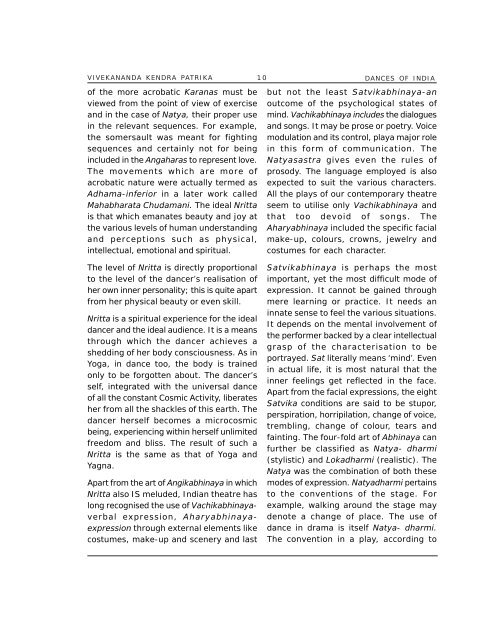Dances of India.pdf - Vivekananda Kendra Prakashan
Dances of India.pdf - Vivekananda Kendra Prakashan
Dances of India.pdf - Vivekananda Kendra Prakashan
Create successful ePaper yourself
Turn your PDF publications into a flip-book with our unique Google optimized e-Paper software.
VIVEKANANDA KENDRA PATRIKA10DANCES OF INDIA<strong>of</strong> the more acrobatic Karanas must beviewed from the point <strong>of</strong> view <strong>of</strong> exerciseand in the case <strong>of</strong> Natya, their proper usein the relevant sequences. For example,the somersault was meant for fightingsequences and certainly not for beingincluded in the Angaharas to represent love.The movements which are more <strong>of</strong>acrobatic nature were actually termed asAdhama-inferior in a later work calledMahabharata Chudamani. The ideal Nrittabut not the least Satvikabhinaya-anoutcome <strong>of</strong> the psychological states <strong>of</strong>mind. Vachikabhinaya includes the dialoguesand songs. It may be prose or poetry. Voicemodulation and its control, playa major rolein this form <strong>of</strong> communication. TheNatyasastra gives even the rules <strong>of</strong>prosody. The language employed is alsoexpected to suit the various characters.All the plays <strong>of</strong> our contemporary theatreseem to utilise only Vachikabhinaya andis that which emanates beauty and joy at that too devoid <strong>of</strong> songs. Thethe various levels <strong>of</strong> human understandingand perceptions such as physical,intellectual, emotional and spiritual.Aharyabhinaya included the specific facialmake-up, colours, crowns, jewelry andcostumes for each character.The level <strong>of</strong> Nritta is directly proportionalto the level <strong>of</strong> the dancer’s realisation <strong>of</strong>her own inner personality; this is quite apartfrom her physical beauty or even skill.Nritta is a spiritual experience for the idealdancer and the ideal audience. It is a meansthrough which the dancer achieves ashedding <strong>of</strong> her body consciousness. As inYoga, in dance too, the body is trainedonly to be forgotten about. The dancer’sself, integrated with the universal dance<strong>of</strong> all the constant Cosmic Activity, liberatesher from all the shackles <strong>of</strong> this earth. Thedancer herself becomes a microcosmicbeing, experiencing within herself unlimitedfreedom and bliss. The result <strong>of</strong> such aNritta is the same as that <strong>of</strong> Yoga andYagna.Apart from the art <strong>of</strong> Angikabhinaya in whichNritta also IS meluded, <strong>India</strong>n theatre haslong recognised the use <strong>of</strong> Vachikabhinayaverbalexpression, Aharyabhinayaexpressionthrough external elements likecostumes, make-up and scenery and lastSatvikabhinaya is perhaps the mostimportant, yet the most difficult mode <strong>of</strong>expression. It cannot be gained throughmere learning or practice. It needs aninnate sense to feel the various situations.It depends on the mental involvement <strong>of</strong>the performer backed by a clear intellectualgrasp <strong>of</strong> the characterisation to beportrayed. Sat literally means ‘mind’. Evenin actual life, it is most natural that theinner feelings get reflected in the face.Apart from the facial expressions, the eightSatvika conditions are said to be stupor,perspiration, horripilation, change <strong>of</strong> voice,trembling, change <strong>of</strong> colour, tears andfainting. The four-fold art <strong>of</strong> Abhinaya canfurther be classified as Natya- dharmi(stylistic) and Lokadharmi (realistic). TheNatya was the combination <strong>of</strong> both thesemodes <strong>of</strong> expression. Natyadharmi pertainsto the conventions <strong>of</strong> the stage. Forexample, walking around the stage maydenote a change <strong>of</strong> place. The use <strong>of</strong>dance in drama is itself Natya- dharmi.The convention in a play, according to
















